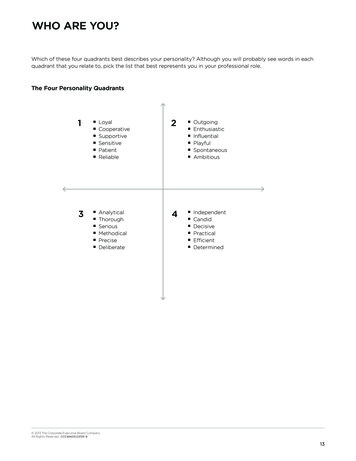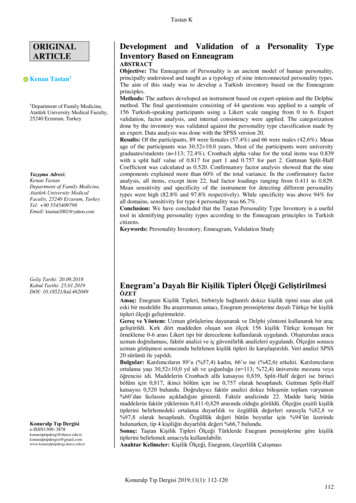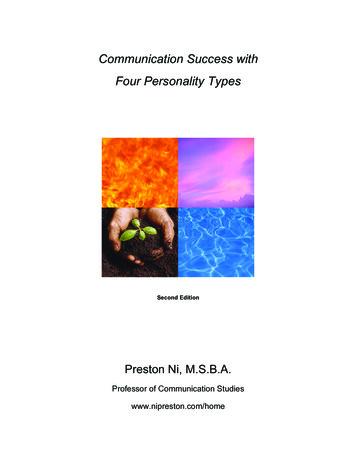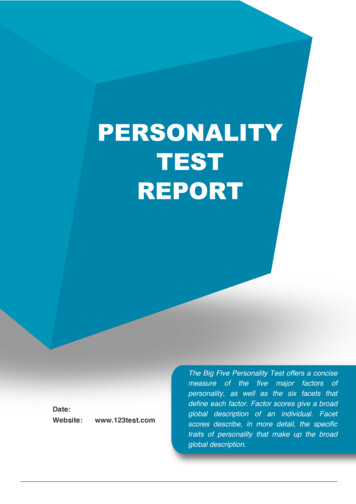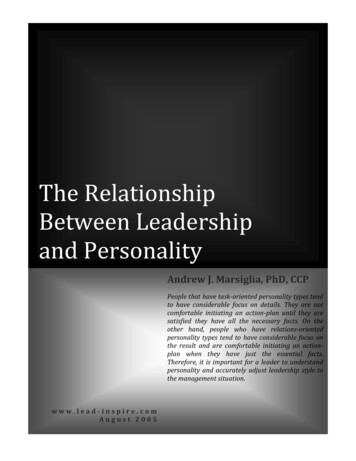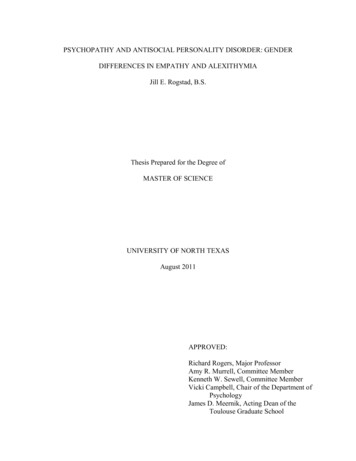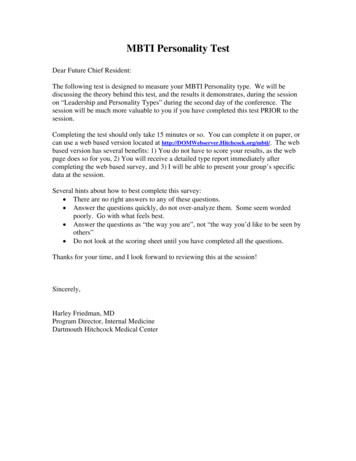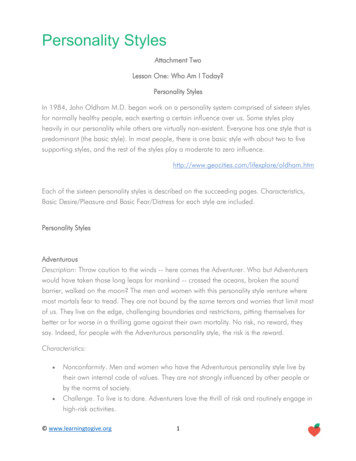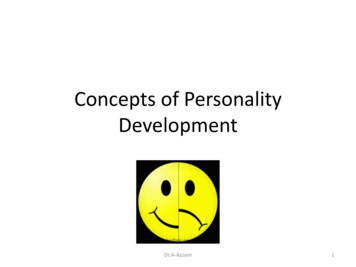
Transcription
Concepts of PersonalityDevelopmentDr.A-Azzam1
Harry Stack Sullivan Sullivan emphasized interpersonalrelationships and social experiences inshaping personality Sullivan’s theorem of escape describes aself-system that is resistant to experiencesthat evoke anxiety Sullivan's theorem of reciprocal emotionsrefers to the interactive influence ofemotions between the self and others, andreflects the interpersonal aspects of anxiety2
Sullivan’smajor conceptsAnxiety is a feeling of emotional discomfort,toward the relief or prevention of which allbehavior is aimed.––Sullivan believed that anxiety is the “chiefdisruptive force in interpersonal relations andthe main factor in the development of seriousdifficulties in living.”It arises out of one’s inability to satisfy needsor achieve interpersonal security.3
Cont; Satisfaction of needs is the fulfillment of allrequirements associated with an individual’sphysiochemical environment.–Sullivan identified examples of theserequirements as oxygen, food, water,warmth, tenderness, rest, activity, sexualexpression—virtually anything that, whenabsent, produces discomfort in the individual.4
Cont; Interpersonal security is the feelingassociated with relief from anxiety.––When all needs have been met, oneexperiences a sense of total well-being,which Sullivan termed interpersonal security.He believed individuals have an innate needfor interpersonal security.5
Cont; Self-system is a collection of experiences, orsecurity measures, adopted by the individualto protect against anxiety.6
Self-systemThe Good Me, the Bad Me, and the Not Me Sullivan made a distinction among threeselves:––The ‘good me’ versus the ‘bad me’ based onsocial appraisal and the anxiety that resultsfrom negative feedbackThe ‘not me’ refers to the unknown,repressed component of the self7
Sullivan’s Stages ofPersonality DevelopmentThe Developmental Epochs Sullivan (1953) outlined sixdevelopmental stages called “epochs”:1. Infancy2. Childhood3. Juvenile era4. Preadolescence5. Early adolescence6. Late adolescence8
Infancy Birth-18 During this beginning stage, the majordevelopmental task for the child is thegratification of needs. This is accomplishedthrough activity associated with the mouth,such as crying, nursing, and thumb sucking.9
Childhood 18-6 At ages 18 months to 6 years, the childlearns that interference with fulfillment ofpersonal wishes and desires may result indelayed gratification. He or she learns to accept this and feelcomfortable with it, recognizing that delayedgratification often results in parentalapproval, a more lasting type of reward. Tools of this stage include the mouth, theanus, language, experimentation,manipulation, and identification.10
Juvenile: 6 to 9 Years The major task of the juvenile stage isformation of satisfactory relationships withinthe peer group. This is accomplished through the use ofcompetition, cooperation, and compromise.11
Preadolescence: 9 to 12 Years The tasks of the preadolescence stagefocus on developing relationships withpersons of the same gender. One’s ability to collaborate with and showlove and affection for another person beginsat this stage.12
Early Adolescence: 12 to 14 Years During early adolescence, the child isstruggling with developing a sense ofidentity, separate and independent from theparents. The major task is formation of satisfactoryrelationships with members of the oppositegender. Sullivan saw the emergence of lust inresponse to biological changes as a majorforce occurring during this period.13
Late Adolescence: 14 to 21 Years The late adolescent period is characterizedby tasks associated with the attempt toachieve interdependence within the societyand the formation of a lasting, intimaterelationship with a selected member of theopposite gender. The genital organs are the majordevelopmental focus of this stage.14
Nursing implication Relationship development is a majorconcept of this theory, and is also a majorpsychiatric nursing intervention. Nurses develop therapeutic relationshipswith clients in an effort to help themgeneralize this ability to interact successfullywith others. Nurses use the concepts of Sullivan’s theoryto help clients achieve a higher degree ofindependent and interpersonal functioning.15
Evaluation of Sullivan’s Theory Sullivan incited interest in interpersonaltheory, particularly on aspects of agencyand communion Critics note the abstract nature of hisconcepts and the resultant lack of empiricaltesting The role of interpersonal factors in histheory may be overextended16
Psychosocial Stages of PersonalityDevelopment/ Erickson8 successive stages over the lifespanAddresses bio, social, situational, personalinfluences Crisis: must adaptively or maladaptively copewith task in each developmental stage – Respond adaptively: acquire strengths needed fornext developmental stage– Respond maladaptively: less likely to be able to adaptto later problems Basic strengths: Motivating characteristics andbeliefs that derive from successful resolution ofcrisis in each stageDr.A-Azzam17
Stage 1: Basic Trust vs. MistrustBirth to age 1 Totally dependent on others Caregiver meets needs: child developstrust Caregiver does not meet needs: childdevelops mistrust Basic strength: Hope – Belief our desires will be satisfied– Feeling of confidenceDr.A-Azzam18
Stage 2: Autonomy vs. Shame andDoubtAges 1-3 Child able to exercise some degree ofchoice Child’s independence is thwarted: childdevelops feelings of self-doubt, shame indealing with others Basic Strength: Will – Determination to exercise freedom of choicein face of society’s demandsDr.A-Azzam19
Stage 3: Initiative vs. GuiltAges 3-5 Child expresses desire to take initiative inactivities Parents punish child for initiative: childdevelops feelings of guilt that will affectself-directed activity throughout life Basic strength: Purpose – Courage to envision and pursue goalsDr.A-Azzam20
Stage 4: Industriousness vs.InferiorityAges 6-11 Child develops cognitive abilities to enablein task completion (school work, play) Parents/teachers do not support child’sefforts: child develops feelings ofinferiority and inadequacy Basci strength: Competence – Exertion of skill and intelligence in pursuingand completing tasksDr.A-Azzam21
Stages 1-4– Largely determined by others (parents,teachers) Stages 5-8– Individual has more control over environment– Individual responsibility for crisis resolution ineach stageDr.A-Azzam22
Stage 5: Identity vs. RoleConfusionAges 12-18 Form ego identity: self-image Strong sense of identity: face adulthoodwith certainty and confidence Identity crisis: confusion of ego identity Basic strength: Fidelity – Emerges from cohesive ego identity– Sincerity, genuineness, sense of duty inrelationships with othersDr.A-Azzam23
Stage 6: Intimacy vs. IsolationAges 18-35 (approximately) Undertake productive work and establishintimate relationships Inability to establish intimacy leads tosocial isolation Basic strength: Love – Mutual devotion in a shared identity– Fusing of oneself with another personDr.A-Azzam24
Stage 7: Generativity vs.StagnationAges 35-55 (approximately) Generativity: Active involvement inteaching/guiding the next generation Stagnation involves not seeking outlets forgenerativity Basic strength: Care – Broad concern for others– Need to teach othersDr.A-Azzam25
Stage 8: Ego Integrity vs. DespairAges 55 Evaluation of entire life Integrity: Look back with satisfaction Despair: Review with anger, frustration Basic strength: Wisdom – Detached concern with the whole of lifeDr.A-Azzam26
Criticisms of EriksonAmbiguous terms and concepts Lack of precision – Some terms are not easily measuredempiricallyExperiences in stage may only apply tomales Identity crisis may only apply to thoseaffluent enough to explore identities Dr.A-Azzam27
Relevance to nursing practice Nurses can plan care to assist theseindividuals in fulfilling the tasks and inmoving on to a higher developmentallevel.Dr.A-Azzam28
Object Relations Theory Object relations refers to interpersonalrelations Object refers to that which will satisfy aneed. significant person or thing that istarget of another's feelings (drives). In combination with relations, object refersto interpersonal relations and suggestsinner residues of past relations shapingpresent relationsDr.A-Azzam29
Object relations theorists investigate theearly formulation and differentiation ofpsychological structure and how theseinner structures are manifested ininterpersonal situations Theorists focus on relationships of earlylife that leave lasting impression within thepsyche of the individual.Dr.A-Azzam30
Object Relations Theorist Share a common concern about the primacy ofrelationships over innate instinctual drives Shifts from instinct to early relationshipsEmphasizes environmental influences. Weight is given to how the infant develops a‘self’ through relationships within family and howthis self relates toward others Study disorders in relationships –(personalitydisorders)Dr.A-Azzam31
Margaret MahlerSeparation – Individuation TheoryNormal Autistic Phase (birth-1 month) - First few weeks of life. Theinfant is detached and self absorbed. Spends most of his/her time sleeping.Mahler later abandoned this phase, based on new findings from her infantresearch.[2] She believed it to be non-existent. The phase still appears inmany books on her theories.Normal Symbiotic Phase (1-5month) - Lasts until about 5 months ofage. The child is now aware of his/her mother but there is not a sense ofindividuality. The infant and the mother are one, and there is a barrierbetween them and the rest of the world.Separation-Individuation Phase ( - The arrival of this phase marks theend of the Normal Symbiotic Phase. Separation refers to the developmentof limits, the differentiation between the infant and the mother, whereasindividuation refers to the development of the infant's ego, sense ofidentity, and cognitive abilities.Dr.A-Azzam32
Subphase 1—Differentiation(5 to 10 Months) The differentiation phase begins with thechild’s initial physical movements awayfrom the mothering figure. A primary recognition of separatenesscommences.Dr.A-Azzam33
Subphase 2—Practicing (10 to 16Months) With advanced locomotor functioning, thechild experiences feelings of exhilarationfrom increased independence. He or she is now able to move away from,and return to, the mothering figure. A sense of omnipotence is manifested.Dr.A-Azzam34
Subphase 3—Rapprochement(16 to 24 Months) This third subphase is extremely critical to thechild’s healthy ego development. The child becomes increasingly aware of his orher separateness from the mothering figure,while the sense of fearlessness diminishes. The child, now recognizing the mother as aseparate. The child needs the mothering figure to beavailable to provide “emotional refueling” ondemand.Dr.A-Azzam35
Subphase 4—Consolidation(24 to 36 Months) With achievement of consolidation, adefinite individuality and sense ofseparateness of self are established. Objects are represented as whole, with theability to integrate both “good” and “bad.”Dr.A-Azzam36
Relevance to nursing practice Understanding the concepts of Mahler’stheory of object relations helps the nurseassess the client’s level of individuationfrom primary caregivers.Dr.A-Azzam37
Peplau’s Interpersonal RelationsTheory Stresses the importance of nurses’ ability to understand their ownbehaviors to help others identify perceived difficulties. Emphasizes the focus on the interpersonal processes andtherapeutic relationship that develops between the nurse and client. Four phases of the nurse-patient relationship are identified Six primary roles of the nurse Six secondary roles of the nurseDr.A-Azzam38
4 Phases of nurse-patientrelationship Orientation-client seekingassistance, meeting of nursepatient, identifying theproblem and services needed( interview process), andguidance. Identification- identifyingwho is best to support needs,patient addresses personalfeelings about the experienceand is encouraged toparticipate in care to promotepersonal acceptance andsatisfaction.Dr.A-Azzam39
Phases cont. Exploitation- patient attempts to explore, understandand deal with the problem, and gains independenceon achieving the goal Resolution- termination of the therapeuticrelationship to encourage emotional balance for nurseand patient ( difficult for both patient and nurse aspsychological dependence persists)Dr.A-Azzam40
Roles of NursesPrimary Stranger Teacher Resource person Counselor Surrogate LeaderDr.A-AzzamSecondary Technical expert Mediator Safety agent Researcher Tutor Manager of environment41
A Nursing Model – Peplau (cont.) Four stages of personality development Stage 1 – Learning to count on others Stage 2 – Learning to delay satisfaction Stage 3 – Identifying oneself Stage 4 – Developing skills in participationDr.A-Azzam42
Application of theory in “MY”nursing practice This theory would be useful with our newly diagnosed cancer patients and their family.Resistance is met when trying to educate them about the treatment, encouragingenrolment in studies, and education about how to care for the patient in their homesetting.– Orientation-patient gets admitted to the unit, nurse helps the patient to recognizeand understand that they have cancer and the importance of treatment.– Identification-Patient takes the time to internalize the diagnosis, the nurseparticipates in helping the patient to do so.-- Exploitation-the nurse works to have the patient explore what help is needed tomeet goals, incorporating other disciplines to problem solve (oncologists, therapists,alternative medicine, etc.).Patient test the limits of the nurses availability, and thenurse encourages patient to evaluate ways to meet their final goals.-- Resolution-when in-patient treatment is complete, the nurse has to evaluatefeelings and remove themselves from the bond that is made, allowing the patient andfamily to move on and regain balance in their own lives.Dr.A-Azzam43
child’s healthy ego development. The child becomes increasingly aware of his or her separateness from the mothering figure, while the sense of fearlessness diminishes. The child, now recognizing the mother as a separate. The child needs the mothering figure to be available

